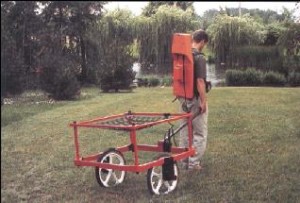Introduction
Construction work as part of a proposed residential development effort in a major Midwestern city revealed the presence of buried steel drums within a portion of the Site. Given the size of the Site, it was determined that geophysical mapping would be an appropriate means to provide a preliminary, non-intrusive assessment of buried metal accumulations. Based on the Site conditions and project objectives, Mundell performed a metal detection survey using a Geonics EM-61 MKII in conjunction with a Trimble Ag114 Global Positioning System (GPS) receiver for survey control. Using GPS to record the instrument location rather than conventional survey methods allowed for the rapid and cost-effective mapping of the more than 4 acres of accessible Site area.
The EM-61 MKII is a high-sensitivity, high-resolution, time-domain metal detector. It consists of two vertically-separated, coaxial, square coils, each with a dimension of one meter by one meter, mounted to a wheel assembly (see photograph below). During operation of the instrument, the transmitter coil is briefly energized, which creates an electromagnetic field (EMF) that induces a secondary EMF in subsurface materials. The decay characteristic of this secondary EMF is then measured with both coils. The EMF associated with poor conductors decays relatively quickly while the EMF associated with conductive metallic objects decays relatively slowly. The additional measurement afforded by using two coils to measure the EMF decay is utilized to filter out the effect of near-surface metallic materials, allowing for a distinction between deeper and shallower metallic objects.
Conclusions
Figures 1 and 2 illustrate the EM-61 MKII metal detection results as a color contour map of the instrument response (in milliVolts). The Channel Three map (Figure 1) shows both above ground and buried metallic objects, while the Channel Difference Map (Figure 2) predominantly portrays buried metallic objects. Using a standard Mundell color scale, Figures 1 and 2 show large accumulations of metallic objects as red to violet with areas of smaller accumulations depicted as yellow to orange, areas with few or no metallic objects are presented as cross-hatched.
The EM-61 MKII metal detection mapping revealed occurrences of numerous sporadically placed metallic objects placed in a somewhat haphazard pattern. The central portion of the Site contains a laterally extensive collection of surficial metallic objects with a number of locations of buried metallic objects within. The two largest EM61 MKII anomalies across the Site represent significant accumulations of buried metal, and have a somewhat organized appearance often seen with systematic drum burials.
- EM-61 MKII Channel Three Map
- EM-61 MKII Channel Difference Map






